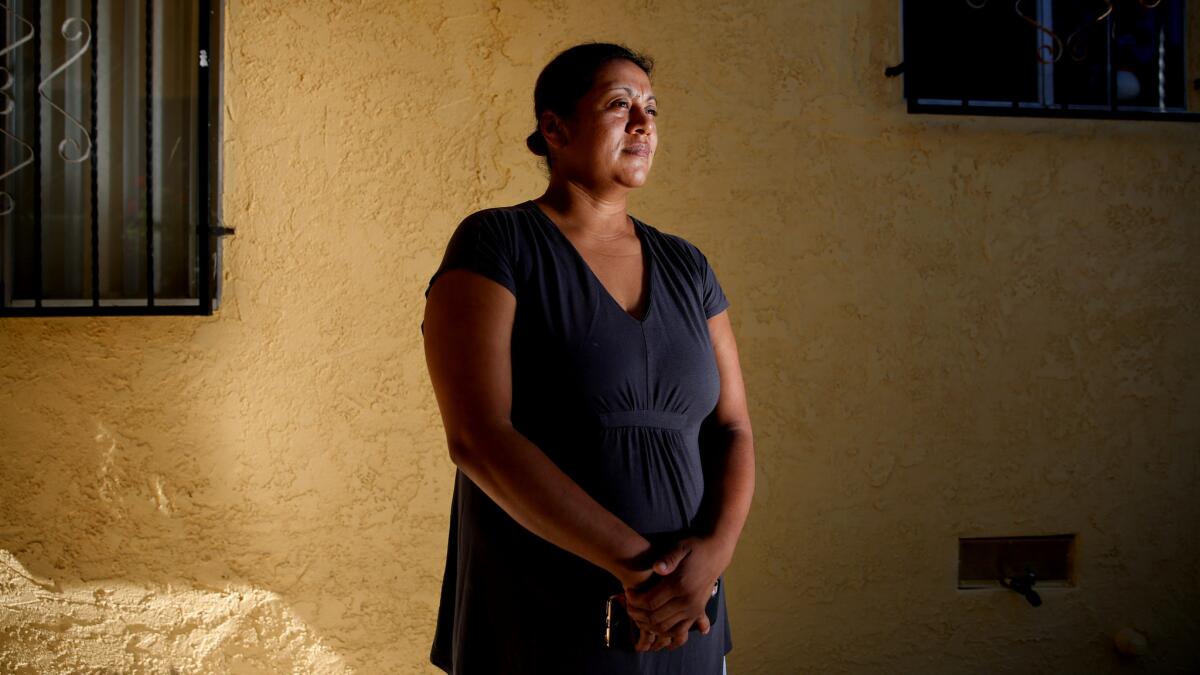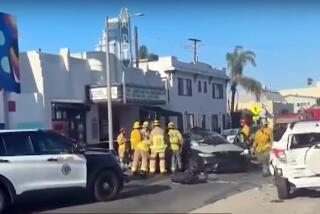Are Los Angeles police chases worth the risk to bystanders? Last year saw record injuries

Seventy-eight people were hurt during LAPD chases they had nothing to do with last year, eclipsing the previous highest tally of 61 in 2005.
UPDATE: A grand jury cited the below analysis by the L.A. Times in a report calling on local law enforcement agencies to revamp how they approach pursuits. A July 11, 2017 Times story details the findings of the grand jury, which said the LAPD and the L.A. County Sheriff’s Department should provide officers with recurring training on driving in pursuits and each department’s trainers should investigate injuries at pursuit crash scenes. Read our story on the report.
Los Angeles police chases injured more bystanders in 2015 than in any other year in at least a decade, a surge that has renewed calls for the LAPD to reform a pursuit policy considered one of the most permissive in California.
Seventy-eight people were hurt during LAPD chases they had nothing to do with last year, eclipsing the previous highest tally of 61 in 2005, according to a Times review of pursuit data reported to the California Highway Patrol. LAPD chases in 2015 injured bystanders at four times the rate of police pursuits in the rest of the state, according to the data.
The number of hurt bystanders, which includes pedestrians as well as drivers and passengers in cars that were not involved in the pursuit, was the highest in Los Angeles since at least 2002, the earliest year for which the California Highway Patrol has available pursuit data. During that year, 57 bystanders were injured. The city has recorded an average of 45 injured bystanders annually in LAPD pursuits, according the data.
In most cases, it is the fleeing suspect whose vehicle collides with pedestrians or other motorists, but some policing experts blame the high rate of injuries on the LAPD’s pursuit policy.
The department allows officers to give chase for a wide array of crimes, including relatively minor offenses such as car theft, reckless driving or driving while intoxicated. Fleeing motorists who are impaired are more likely to cause a crash while speeding or driving erratically as they try to escape, critics contend.
“The tragic outcomes of these chases are well-documented. The injuries to the cops are well-documented,” said Eugene O’Donnell, a former New York City police officer and prosecutor who now teaches at the John Jay College of Criminal Justice. “Every one of these, you’re playing with fire.”
Last year, a Los Angeles Times review of pursuit statistics showed LAPD car chases from 2006 through 2014 led to bystander injuries and deaths at a higher rate than pursuits in the rest of the state.
LAPD officials argue it is unfair to compare bystander injuries in L.A. to those in other cities, because Los Angeles’ sprawling web of freeways and multilane thoroughfares allow fleeing vehicles to travel at greater speeds and make wild turns through traffic, increasing the likelihood someone will be hurt in a chase.
Last year’s rise in injuries, they said, coincided with an increase in pursuits across the city and state. The LAPD was involved in 527 chases last year, compared with 345 in 2014. Investigators with the LAPD and CHP could not give a specific reason for the increase in pursuits in California.
“The instances, the people willing to flee and choosing to flee, is what’s on the rise here,” said LAPD Lt. David Ferry, who reviews all car chases conducted by LAPD officers.
Most injuries to bystanders, LAPD officials said, were relatively minor. And the first five months of this year saw a 45% decline compared with the same period in 2015, according to the most recent data provided by the LAPD.
Chasing suspects, LAPD officials said, is a necessary tactic to combat crime. Car thefts have been the leading cause of Los Angeles police pursuits for years, records show, and officials say they need to capture car thieves immediately to prevent them from using the vehicles in violent crimes.
“When you take a vehicle, a stolen vehicle, sometimes it’s just for joyriding, but sometimes it’s to be used in more felonious crimes that are predatory and are a danger to public safety,” Ferry said. “We have an obligation to protect the public.”
Pursuits increased throughout the rest of California last year by 24.4% without a similarly sharp rise in injuries to bystanders. The number of those hurt inched up from 231 in 2014 to 234 last year, according to The Times’ analysis.
Overall, 188 people — including fleeing drivers, their passengers and chasing officers as well as bystanders — were injured during LAPD pursuits in 2015, also marking the highest total since 2002. The previous highest was 161 in 2004.
Compared with Los Angeles, bystanders were less likely to be injured in pursuits that took place in other dense, urban areas, including Long Beach, San Francisco and Oakland, where police have more restrictive policies on chasing suspects.

Nick Phoenix speaks about the death of his teenage son, Jack, who was struck and killed by a stolen car that was fleeing the LAPD in 2015. While police contend they weren’t chasing the car, Phoenix holds the LAPD responsible for his son’s death.
The LAPD’s pursuit policy has been undergoing revisions since 2015. The revisions are routine and not in response to any criticism, according to Ferry, who said they would be made public once they are sent to the civilian Police Commission for approval.
Geoff Alpert, a professor at the University of South Carolina who authored a report on pursuits for the National Institute of Justice, said officers make dangerous situations worse when they chase reckless or drunk drivers. Chasing an out-of-control driver — as the LAPD allows — will create a larger public safety threat because the already erratic driver will travel at higher speeds and make more reckless decisions in the hopes of evading police, Alpert said.
“If it’s not a violent crime, it’s not worth raising [the] risk to the public,” he said.
One of last year’s crashes occurred as LAPD officers were chasing a reckless driver through South L.A. The February 2015 pursuit spanned three miles until the fleeing vehicle slammed into two cars that had been waiting at a light at Imperial Highway and Main Street.
In one of the cars was Juana Duran Tirado, her 2-year-old son and her 20-day-old daughter.

Tirado, 38, said the last thing she remembers from that day was pulling her Ford Explorer forward as the light changed to green. She was briefly knocked unconscious when the fleeing driver’s car smashed into hers. She awoke moments later to find police and firefighters trying to free her from her wrecked car. She turned to the backseat to search for her children, but they weren’t there.
“I was really scared,” said Tirado, a mother of four who works at a food truck in Echo Park.
Police reassured her that the children were fine and had been taken to a hospital for observation. They were not injured, Tirado said.
But the crash had long-lasting effects on Tirado. She suffered a fractured arm and injuries to her neck and back, as well as cuts across her face when the windshield shattered, she said. She was unable to work for about two months and hasn’t been able to afford a new car. Her son, now 3, often freezes when he sees another car accident, she said.
Tirado said she blames both the police and the fleeing suspect for the injuries she suffered, and wondered aloud if the LAPD should be chasing motorists for driving violations.
“On the one hand, there are times when it is necessary, because the people they’re chasing are putting others at risk,” she said. “But on the other hand, when police are chasing them and speeding, they’re putting more people at risk.”
One other bystander was injured in the car struck alongside Tirado’s. The fleeing driver, Roderick Ingram, was also injured, as were two children in his car, including a 1-year-old. Ingram was under the influence of a “combination of substances,” according to a police report. Court records show Ingram pleaded no contest to two counts of child endangerment and one count of driving under the influence. He was sentenced to seven years in state prison.
In addition to bystanders, seven LAPD officers were injured during pursuits last year, according to the CHP records. Two suspects in a South L.A. shooting also died after their fleeing van slammed into a city fire truck. No city employees were injured in that collision.
Nine bystanders were killed during LAPD pursuits in the last decade. The department reported none last year, but the family of a Venice teenager who was killed in November 2015 by a driver fleeing LAPD officers filed a lawsuit this year blaming police for his death.
Court records show that officers in a marked cruiser tailed a stolen Buick LeSabre for several miles from Mid-City to Palms, including along a stretch of the 10 Freeway.
In court, one of the officers testified that she radioed for a police helicopter and other officers so they could stop the LeSabre as they followed behind. She said she and her partner continued to follow the car at speeds above 60 mph without turning on their lights and sirens. They did not attempt to stop the driver as he sped along Venice Boulevard, she testified.
The stolen car was traveling at 90 mph when it struck 15-year-old Jack Phoenix as he crossed a street in Palms. The teen was decapitated, according to the lawsuit and a police report.
Ferry and an LAPD spokesman said the department does not consider the incident a pursuit because officers did not attempt to stop the vehicle. Ferry and the spokesman declined to comment further, citing the pending litigation.
It is unclear how many bystanders have been killed or injured in similar collisions that the department does not formally consider pursuits. While the LAPD keeps records of all car crashes involving its officers, the department does not specifically track injuries or deaths in car accidents caused by vehicles that LAPD officers were following unless they are considered official pursuits, Ferry said.
The suspected driver, Paul Brumfield, was arrested days later and charged with murder, felony evasion and car theft, court records show. He has pleaded not guilty.
But the victim’s father, Nick Phoenix, said he blames the LAPD for his son’s death. Phoenix called the LAPD’s position that officers were not in pursuit of Brumfield a distinction without a difference.
Phoenix said his son was a talented graphic designer and artist who adopted the nickname “Sake” while he developed drawings and shirt designs that bear a graffiti- and anime-infused style. The family has opened a clothing store on La Brea Avenue with the same name to honor the dead teen, whose designs are plastered across every item in the store.
“This probably never would have happened if the police hadn’t done what they did, and they’re the ones who are supposed to be responsible,” Phoenix said. “They’re the ones who are supposed… to be careful, to protect the people.”
Los Angeles Times staff writers Brittny Mejia and Ben Poston, and Staff Photographer Gary Coronado, contributed to this report.
Follow @JamesQueallyLAT for crime and police news in California.
ALSO
Anti-Trump protesters shut down 101 Freeway in L.A., burn Trump’s head in effigy
L.A. Valley College evacuated amid unconfirmed reports of shooting on campus
Uber driver charged with raping unconscious 17-year-old in Orange County
More to Read
Sign up for Essential California
The most important California stories and recommendations in your inbox every morning.
You may occasionally receive promotional content from the Los Angeles Times.











